The Story of Inty
Curing Founder Using the Strasser Method
by Yvonne M. Welz
Note in September, 2009: This is a reprint, as published in a magazine in 2001. Please read this article as HISTORY, and as a WARNING, and understand that I do not agree with some of the "advice", which proved, inevitably, to be unsuccessful. I especially do not believe that any horse should live in pain, nor should it ever be forced to move while in pain, and I believe euthanasia can be an extremely kind option.
THE MORAL of this STORY: Save your horses NOW, while their hooves have not yet foundered, while they are still healthy. Prevention is everything. A healthy hoof is the ultimate prevention against hoof disease.
As published in Natural Horse Magazine, Vol 2, Issue 5 and 6 in 2001
www.naturalhorse.com
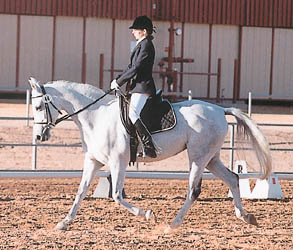
Inty and Yvonne, 1993
Printed exactly as published:
My world came crashing down on May 24th, 1999. My beloved half
Lipizzan, half Arabian mare, Interlude Vedera (Inty) was stricken with severe
laminitis and subsequently foundered.
You see, Inty was a horse that dreams are made of. The first
time I ever saw her, she was doing a magnificent passage around a paddock.
She was 7 years old and unbroke, but I bought her without a second thought.
I trained her myself, from scratch, with just the help of some good books
and a few lessons. We competed successfully through second level dressage,
actually earning scores of “9” on three separate occasions. A German-educated
dressage professional once told me that she had “world class gaits”
and could be competitive on a national level.
After some clinics with a French Classical dressage trainer, I taught Inty to piaffe, spanish walk, and do flying lead changes. Her high level of training made her such a fun horse to ride, whether it was climbing the rocky trails of Sedona, Arizona, or galloping around the track area at the stables.
Laminitis Without Cause?
There was no incident that led up to the laminitis. It literally
came out of the blue, overnight, with no cause, no reason, and no mercy. Knowing
what I know now, I see that we were headed for disaster all along. After all,
for the entire 8 years that I had owned her, she had been living in a stall,
body-clipped, blanketed, and shod in a various assortment of therapeutic bar
shoes in a effort to help her “poor-quality” feet.
Monday, May 24th, she showed a moderate lameness in her right
front foot. My farrier was there, and he thought there might be a corn under
her shoe, as she was due for re-setting. He pulled the shoes, was unable to
find a problem, and set her in heartbars, as she had worn them in the past
for “therapeutic” reasons. When her lameness was the same the next
day, I called the veterinarian. I must stress that the possibility of laminitis
was the furthest thing from my mind! I had no idea that such a thing could
happen without an obvious cause. Inty was a bit overweight at the time, and
had been diagnosed 5 years earlier as "hypothyroid", so that is
all we had to blame it on. Here is my chronicle of the events that ensued:
5-26-99 My Primary Vet X-rays and diagnoses laminitis. There
is no rotation in this initial set of X-rays. Digital pulse is high in right
foot and she shifts constantly between both front feet. Start on oral bute
1 gram morning, 1 gram evening; 5 days of Ace injections; and DMSO gel applied
to coronary bands. Total stall rest on deeply bedded shavings is prescribed.
Over the next month, Inty continues to worsen, and becomes sore
in the left front foot also. On 6-29-99, Primary Vet takes 2nd X-rays. Severe
rotation (8 degrees) in right foot, minor changes in left. The next day, a
Hoof Specialist Vet is called in to evaluate X-rays, and she determines that
we should leave her untouched for 30 days (no changes in shoeing at all, shoes
left on as is, with no trim or reset) and X-ray then. She says the heartbar
shoes are in exactly the correct spot to serve their purpose (stabilization
of the coffin bone). We are to continue total stall rest.
Inty continues to worsen, especially in the left front foot.
On 7-14-99, Primary Vet looks at her left foot. He pulls out a rusty nail
on the inside back and thought it looked like there may be a bruise in that
area. We put a Easyboot over that hoof and shoe. She seems to stabilize with
only some favoring in the left foot, so we begin to try and decrease the bute
back to 1 gram twice a day.
7-27-99 Primary Vet takes 3rd set of X-rays. She is suddenly
very bad in left front foot again. Will not put weight on that foot. There
is a whole flap of loose sole falling off her left hoof and the Primary Vet
pulls it off. There is also what looks like an abscess draining on her coronary
band of the left hoof. Her entire sole is soft and something is severely wrong
in that foot. Primary Vet pares into the sole a little bit to see what is
going on, and seems to realize he has done too much. Put Easyboot back on.
The developed X-rays reveal 8 degrees rotation in left hoof now, with almost
no sole under the coffin bone. The right hoof was about the same as last X-rays.
7-28-99 She is much worse today, and lays down for the first
time. She cannot weight her left foot at all and spends most of the day down.
She seems to be in severe constant pain. We increase her bute to 2 grams twice
a day. The bottom of the sole has now opened up about 1/4 inch in the area
where the vet had pared it.
7-30-99 Hoof Specialist Vet and two consulting farriers meet
with us. Inty is really bad, laying down a lot, and holding the left foot
off the ground entirely. Her entire lower left leg is beginning to swell.
Specialist Vet tells the farriers that we will not be removing her shoes at
all, so they didn’t need to be there. She explains that the hoof is collapsing
inwards under the coronary band and must be opened up in that location or
she will burst through the sole (sole penetration). She says that any changes
to the angle of her feet by trimming or removing her shoes may cause sole
penetration. The general premise seems to be that sole penetration is the
worst thing that could possibly happen (I now know this to be untrue) and
that preventing this was our immediate goal.
She then proceeds to use a dremel tool to remove the hoof wall
of her left forefoot, just barely under the coronary band, in a horizontal
line that is parallel to the coronary band, about 5 inches long and 3/4 inch
high, extending from the front of the hoof to the inside rear of the hoof.
She calls this a “coronary grooving”. Underneath is raw, pink tissue.
She says that the whole open area will harden up in 3 weeks and until then
we are to put betadine on the tissues, wrap the entire hoof with Vetwrap (changed
every 2 days), and put her on antibiotics. Continued stall rest is prescribed.
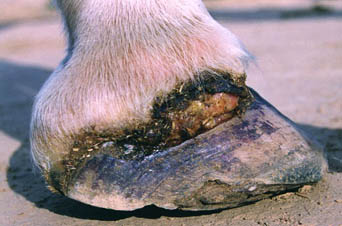
Left Front Coronary Prolapse 9-24-99
The Coronary Grooving
Inty is supposed to improve because of this procedure of “coronary
grooving”. I was in such a desperate state at the time, I would probably
have let someone cut off her ear if they told me that would make her better!
I was trusting the experts, and I allowed this procedure of mutilation to
take place.
I still do not understand the reasoning behind such a drastic
measure. How can inflaming and irritating the hoof tissues and exposing the
laminae to the open elements create healing of the laminitis? If I had known
the whole story behind grooving and resections, and how this would create
months of pain and delayed healing, I would never have considered such a thing.
8-1-99 Inty seems even worse. She is laying down groaning. The
4 grams of bute a day don’t even seem to be working. A couple days later,
pink raw tissue (laminae?) begins protruding from the opening on the bottom
of her sole. It looks like a little finger sticking out.
A Downward Spiral
For the next week, she does not progress. Rather, she is a bit
better, then much worse, over and over again. Things get so bleak, Inty is
suffering so constantly, that I begin to consider euthanasia. I am almost
in constant tears and completely torn apart inside. The vets have no answers
for me, it is just “wait and see”. I think they were becoming doubtful
as to her fate. Certainly at this point, it was only a salvage case. She would
never be ridable again.
Now her left foot is bulging more on the bottom and her leg
is swelling up. The tissue is still sticking out on her sole and doesn’t
seem to be improving. At my request, Primary Vet comes out and looks at her.
He puts her back on antibiotics and provides an ointment to apply to the tissue
on the sole. The Specialist Vet's plan is to continue treatment with the heartbar
shoes as soon as she could be re-shod, but so far she has been in the same
shoes for nearly 3 months! There seems to be no end to Inty’s suffering.
A Glimmer of Hope
Out of sheer frustration, I had spent the past couple of months
searching the internet for anything with the keyword "laminitis"
in it. Most of the information was just downright depressing, but I found
a very intriguing site that kept drawing me back to it. The site is titled
"Treating Founder (Chronic Laminitis) Without Shoes" (http://members.screenz.com/gretchenfathauer)
and is written by Gretchen Fathauer. Within this extremely detailed and photo-filled
site, she describes her experiences with her foundered horse Max and her discovery
of a treatment method that can actually heal the foundered horse's feet. Her
website is a wealth of information, and I studied it avidly. On this website,
I also discovered a link (Star Ridge Publishing's website: http://www.alltel.net/~star/index.html)
to order Dr. Hiltrud Strasser's and Jaime Jackson's books. Hiltrud Strasser,
DVM, a German Veterinarian and founder of the European Institute for Hoof
Orthopedics (ESHOP), is the originator of this treatment method. Jaime Jackson
is a former farrier who, after spending many years studying the feet of wild
horses, began to de-shoe instead, and is Dr. Strasser’s greatest proponent
in America.
The premise of this method is surprisingly simple. Remove the
horse's shoes, trim the feet in a special way that simulated the natural hooves
of a wild horse, turn the horse out to live with other horses in a pasture
or paddock, hand-walk or exercise the horse as much as possible, and provide
daily hoof soaks in water. In essence, return the horse to a more natural
state, to allow his hooves to heal the way nature intended--a truly wholistic
approach to healing this horrible affliction of our modern horses. The key
to the whole healing process is a restoration of the natural “hoof mechanism”,
something that is prevented by horseshoes or improper trimming or living conditions.
Horses’ hooves must be able to expand and contract with every step, creating
constant circulation through the hoof and lower leg, 24 hours a day. Without
“hoof mechanism”, circulation is diminished to dangerous levels.
And any horse that wears shoes, or is kept in a stall for any length of time
has had this natural hoof mechanism taken away.
I finally received Dr. Strasser’s book “A Lifetime
of Soundness”, and Jaime Jackson’s books, “The Natural Horse”,
and “Horse Owners Guide to Natural Hoofcare”, and read these books
from cover to cover, immediately. They literally changed my life, overnight.
Suddenly there was a glimmer of hope! Maybe we could save Inty. Was there
really a miracle cure? Would such a simple, natural treatment method succeed
where standard veterinary medicine had failed?
But then began my conflict. This would go against everything
that the professionals were telling me to do. This would alienate me from
my vets, my farriers, even my friends! I would have to completely change my
entire equestrian life, and abandon all the practices that I had spent so
many years defining. Would I have the courage to proceed with this enormous
task at hand?
For the love of a little grey mare, of course I would.
But I couldn’t do it alone. I needed something and/or someone
to validate what I was doing. I began e-mailing Gretchen Fathauer, author
of the website, and she gave me so many leads and tips to get started. With
Gretchen's help, I began talking on the internet to people all over the country
having similar experiences. She pointed me in the right direction and literally
gave me the courage to begin. She referred me to Frank Orza, the inventor
of the Horsneakers hoof boot (www.horsneaker.com) and supporter of the natural
hoofcare movement. Since he also lived in Arizona, she thought he might be
able to assist me in some way.
8-18-99 Talk to Frank Orza (inventor of Horsneakers) and his
wife Mary from Tombstone, Arizona. After hearing my story, they offer to drive
to Phoenix the following Sunday and pull Inty’s shoes and teach us how
to trim. The next day, I move Inty into a 1 1/2 acre pasture, along with my
other horse. Overnight she changes from a depressed, moping creature that
was lying down most of the day, into a much happier horse that now looks like
she will survive.
I also attempt to discuss these new methods with the Specialist
Vet, but she is not cooperative and basically tells me that I am on my own.
She doesn’t return my last couple of phone calls.
8-22-99 Frank Orza and wife Mary come to counsel and remove
Inty’s shoes, which had been on, untrimmed, for 3 months now. When we
removed the bandage, the infection underneath had a horrible smell. The entire
coronary area was grossly swollen with raw flesh. Frank must use a hacksaw
to remove her right front shoe, as she cannot lift that foreleg at all! We
get the shoes off and Frank gives my husband, James, instructions on how to
rasp her feet every day to try to get the heels down and the toes shortened.
Her hooves are so very long now, with dangerously high heels! Note: Today
is her very last dosage of bute. She had been taking bute every day for the
past 3 months.
Over the next week, she continues to get a little better every
day, for the first time. Every day I walk her around the pasture and twice
a day her open areas are washed. The swelling goes way down in the area of
the coronary band over the grooving. The pus stops coming out of the grooving
area. The sole of her left fore begins to flatten out. The opening begins
to seal up a bit and the tissue no longer protrudes as much and is less sensitive
and harder. She is off all painkillers, and is uncomfortable, but okay. She
lays down some every day, but is up and walking slowly around most of the
time.
The Strasser Method
Although we have made some progress, I do realize that we need
more help. I decide to contact Sabine Kells, Dr. Strasser's associate in Canada
(who is the first Strasser-certified Hoofcare Specialist in North America),
for the photo consultation that Gretchen Fathauer had told me about. This
involves mailing photos of your horse’s feet to Sabine, and she then
critiques your trimming and gives advice on how to implement the Strasser
method of rehabilitation.
I call Sabine on 8-30-99, and we talk at great length about
Inty and what has happened to her. She is very concerned about this “grooving”.
We agree that I will mail photos ASAP. My package to her includes not only
complete photos of Inty’s hooves with our attempt at trimming, but also
the videotape that I had been making of her since the day her shoes were pulled.
Sabine’s immediate instructions are to begin soaking Inty’s left
forefoot daily in apple cider vinegar water, and to leave the grooving area
unbandaged.
9-2-99 After lending him a copy of Dr. Strasser's book to read,
I finally muster up the courage to talk to my Primary Vet about the direction
I have now taken. Even though he is skeptical, he tells me that if this helps
my horse, he is happy that I made this decision.
Our Attempts at the Trim
For the first 2 weeks after our crude attempts at the trim,
there appeared to be no real progress. She seemed to get more uncomfortable
after each trim. The grooving area became slightly more swollen, and turned
from red to white, but stayed soft and moist. The third week after our attempts
at the trim, there was significant progress in her comfort level. After a
trim which ended up taking a lot of heel off the left front foot, she began
to put more weight on the left front and to walk better, more willingly and
more evenly. On 9-22 she willingly lifted up her right front foot for the
first time in months. The grooving area also began to scab over, but unfortunately
this was temporary and the scab fell off and the area continued to swell and
inflame.
At this point, the condition of the left and right hooves was
worrisome. The left front grooving area showed little to no growth above the
swollen, inflamed coronary band. There was a wrinkle in her hoof wall that
continued past the grooving area on both sides, that looked as though the
hoof wall was buckling or collapsing. This ended about midpoint on the front
of her hoof, then the outside of the hoof did not look too bad. The sole of
the left front was bulging, and the bulge was uneven, with most of the bulge
on the inside of the hoof, so that it appeared the coffin bone was twisted.
She was actually standing on the coffin bone bulge, with no weight on the
hoof walls, which had shrunk up or broken off since her shoes were removed.
The opening on the toe sole closed over and hardened, but then cracks appeared
right next to it, closer to the front of the toe, right behind the white line.
The right foot was showing a dip of horn all around the front
below the coronary band. It had some questionable looking spots on the sole,
and had probably been abscessing too, but I was unable to soak it in a bucket
of vinegar water as she would not lift the that foot.
The two hind feet, although not originally diagnosed as having
laminitis, both began showing signs that they too had suffered. The right
hind seemed especially painful, as she totally refused to lift the left hind
foot at all. Both seemed to have an odd shape, and seemed uncomfortable when
she walked.
9-22-99 Sabine receives the package and calls me, very distressed
about what she sees going on with Inty’s feet. She says this is a very
bad, very serious case, and really is a “clinic” situation. She
says that the "grooving" that had been done to her left front hoof
will significantly delay her healing and lengthen the time needed for a full
recovery. We would be looking at possibly 2-3 years for total recovery, though
she may be sound in one year. She says it will be hard, next to impossible,
to convey what we need to do without first-hand experience. Because of the
seriousness of Inty’s feet, and how crucial the trim will be to her recovery,
Sabine convinces me to send my husband to Canada to train with her for a couple
days. We decided for James to train first because he had already been working
on trimming, is more physically talented than I am, and learns skills very
quickly.
9-24-99 through 9-27-99 James flies to Vancouver Island, British
Columbia, to train with Sabine Kells. When he returns, he tells me it was
worth every penny. He learned so much while he was there. Even though we had
previously studied the books and tried so hard to do a correct trim, he said
that we didn’t even have a clue what we were doing! Without hands-on
experience, it is next to impossible to trim the hoof in such a seemingly
drastic way! Even though his training was short, Sabine had given James the
tools he needed to get started. Not only mental tools, but also German hoof
knives, the only kind that can be made sharp enough for a Strasser trim!
9-28-99 James trims Inty’s left front foot (the bad foot).
It is simply amazing—when he is done, she literally has a brand new hoof.
I am in shock at how much hoof he was able to remove.
Over the next several days, he slowly finishes the first round
of the trim on all her feet. This trim is very time-consuming, especially
for the beginner, and very meticulous in its details. And it is almost never-ending
(there is always something else to work on) which is why they recommend trimming
at least twice a week. Most of the trims simply involve refining your last
trim.
The daily ritual of Inty’s care since we began the Strasser
method is quite simple. She is kept in a large, dry-lot “pasture”
with a herd of other horses. She is fed free-choice grass hay, a small amount
of alfalfa hay, a couple pounds of whole oats, free choice minerals and salt.
She is hand-walked twice a day (using a whip when necessary to force her to
walk) for at least 20 minutes at a time. (Ideally, exercise should be even
more than that--I was only making a couple miles a day and the goal is up
to 15 miles a day!) All four feet are soaked daily in water or mud for 20
minutes, and her left forefoot with the grooved area and any abscessing feet
are soaked in a bucket of water mixed with apple cider vinegar. She is trimmed
almost constantly at first, but as she recovers, trims are cut down to just
once a week.
Upon Sabine’s advice, I have discontinued all feed supplements.
These did include Farrier’s Formula, MSM and thyroid medicine (the thyroid
medicine was discontinued very slowly). Given natural living conditions, Sabine
feels all these things are unnecessary. The only supplements should be free-choice
minerals and salt.
The Abscessing Phase (from Bad to Worse?)
Right after the trim, expect the abscessing phase to begin.
The trim sets into motion and accelerates the healing processes, and this
involves the excrement of all the dead tissue inside the foundered hoof. There
is simply no other way for the body to get rid of this necrotic hoof tissue,
so abscesses form all around the hoof capsule, the coronary band, the sole,
even the pastern. This is probably the hardest period to get through! You
know you are on the path to recovery, yet your horse seems worse. At this
point, you really need some Strasser support people to hold your hand. The
abscesses make you feel like you are regressing, but you’re really making
progress!
After the full trims, Inty was more sore and began to severely
swell up in her left front leg. I was also worried about her weight, since
she had lost so much weight and her ribs were really sticking out badly.
10-8-99 Receive Propalis Tincture from Sabine and begin applying
it to her open area (grooving) on left front hoof. The grooving area had not
healed up after 2 1/2 months of being an open, oozing wound. It wasn't until
I began applying the Propalis that it finally healed.
10-9-99 When I arrive, her entire left front leg is even more swollen! I begin to walk her, and when I look down I see her coronary band on the outside of the hoof looks funny. I touch it, and it bursts open, bleeding - an abscess must have just burst open. We continue walking, and she improves, and the abscess continues to drain. I soak the foot for a couple hours, and note how much more comfortable she appears to be, finally putting weight on the left front, and able to stand without so much shifting to the rear.
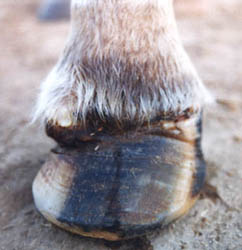
Left Front Abscessing 10-13-99
I began to wonder just how many more abscesses may be in there,
still waiting to come out. The next time James trimmed, he also popped open
a large abscesses on the heel area of her left front sole. A few days later,
an abscess begins draining on the front of the coronary band. Draining continues
off and on for weeks, usually showing up during our daily walks.
James is still worried about Inty losing the left front hoof
capsule. The attachment is probably very weak, since the grooving side is
destroyed, and now the abscesses are encircling her good outside areas. The
only truly intact area is the outside heel. Hopefully it will hang on. Also,
there is still no true growth in the center of the grooving area. The sides
are coming in, but about 1” wide in the center, there is nothing. Frog
is still mutated into sole about halfway down. James thinks entire foot may
be shifting position backwards to realign with coffin bone. James says that
every time he trims, her hoof is completely changed--it appears to be totally
remodeling itself.
When I consider the major structural changes that have taken
place in Inty's hooves during this healing process, I cannot help but wonder
how on earth this could have taken place if she had continued to wear shoes.
It is obvious that it could not have happened! Herein lies the key to the
entire problem. Shoes prevent the changes necessary for healing. A shod laminitic
horse will never make a full recovery.
Week of 10-19-99 Inty continued to be sore and swollen in her left front leg. Her sole looked very bruised. Leg swelling begins to taper off. She continues to drain abscesses on her coronet band, and sole both heel and toe area. She begins the pattern that continues on for many months--better for a few days, then worse, over and over again as the abscesses continue to plague us. But something inside me gives me the faith I need to forge ahead. I know in my heart we are on the correct path.
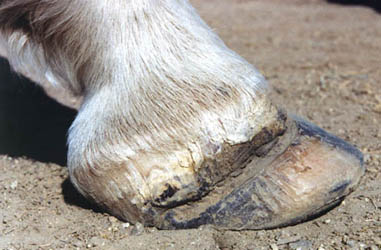
Left Front grooving finally healing up 11-22-99
By November, she is abscessing in her right front foot also.
The good news is that her left foot is feeling a lot better. The swelling
is almost completely gone in the coronary area, and there is good hoof growing
in, very slowly. She is really improving, moving around more and laying down
less, and walking better and better. The grooved area is completely healed
over and hardened. (The grooved area was supposed to heal over in 3 weeks,
instead this took over 3 months!)The growth of her hooves continue to accelerate.
The next several months continued along the same lines. Despite
the constant ups and downs, we were making slow but steady progress overall.
Abscesses drained, sometimes she was very sore, and constant changes in the
structure and shape of the hooves seemed to be the norm. By January, she began
to walk sound on soft ground most days. The sparkle returned to her eyes,
and she gained back the weight she had lost.
By February 2000, the grooving area had grown down to the bottom of the left hoof, but looked like it was pinching as she walked. James began trying to remove most of the excess “slipper” of foundered hoof from the toes of both front feet. A few more serious abscesses emerged, and each time, I prayed that it was the last one. By April, the grooving was nearly gone, with only remnants remaining on the front of the toe. Her front feet now had quite a bit of concavity, and her hind feet were beautiful, healthy hooves with lots of concavity.
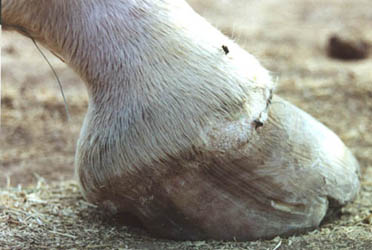
Left Front grooving grown out 7-23-00
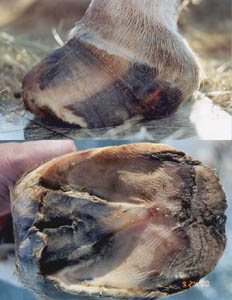
Left Front 9-24-00
Back in the Saddle Again
April 2000: Inty is walking sound on soft ground most of the
time. She still has a ways to go, but it has only been 6 months since her
first proper trim. (At that time, Sabine told me to expect her to be sound
in 1 year, so I think we are right on schedule.) By the end of the month,
Inty is walking so good, I decide to put a bareback pad on her and hop on.
I swear she is happy when I get up on her back! She begins to really walk
out, and is walking almost sound. Certainly no worse than when I was handwalking
her. And Sabine is right, as soon as I start riding her, we begin to go much
further than before. It just seems easier, and she is actually more eager
to walk with me on her back.
May 2000: I have been riding Inty (at a walk only, of course)
for a few weeks now. She is only getting better and better! The further we
ride, the better she walks. It has definitely given us both new inspiration.
I think we are finally over the worst of it, and things can only get better
from here!
This certainly isn’t the end of the story--rather, it is just the beginning. We may have far to go to total recovery, but we really have come a long ways. What was one of the worst experiences of my life has become life-changing in such a positive way. I may have never discovered natural hoofcare and the deeply imbued philosophies behind it, if it were not for the illness of my beloved mare.
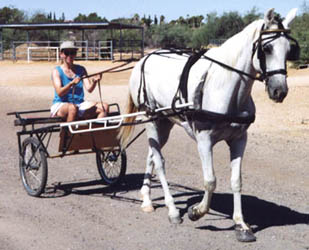
Inty Summer 2000
Advice to Other Horseowners with Laminitic Horses
Unfortunately, this method is often turned to as a last resort,
when traditional methods have failed. By this point, such severe damage has
been done to the hoof capsule that recovery will never be painless or easy.
This method is not for the faint of heart! You must be prepared
for a high level of commitment. You cannot combine the Strasser method with
other approaches. Strict adherence to the principles is mandatory! If you
are not thoroughly versed in these principles, then you must educate yourself.
The horse's shoes must be removed immediately, of course. He
must be taken off all drugs. He must be put into a natural boarding situation
of 24 hour/7 day turnout in a herd of other horses. You must be prepared to
spend the necessary time every day to soak all 4 feet in water, and any abscessing
hooves in vinegar water. The horse must be hand walked, and later ridden,
as much as you are able to do, up to 15 miles a day. If the horse is unwilling
to walk, he must be forced to walk, with the help of a whip, if need be. This
is not cruel, this is rehabilitation.
You must be willing to do what is necessary to become educated
in the very specialized trim needed for the foundered horse. The trim will
be crucial to your horse's ultimate recovery, and you will most likely need
hands-on training or expert help to do the trim correctly.
Most importantly, you must be willing to endure the healing
process. Inevitably, your horse will abscess as soon as your trim is correct
(and may continue to abscess for up to a couple years!) This is not the point
at which to give up! This is a sign that the healing has begun. Do not feel
sorry for the horse and give him drugs or allow him to lay down for long periods
of time! You must be as brave as your horse will be. The pain will pass, and
will soon be forgotten. If this method is strictly adhered to, you horse will
make a complete and total recovery. No other method can provide such incredible
results.
What could have been just another tragic tale of laminitis has
instead become a heroic journey for me and my horse. What I have learned on
this journey will affect the rest of my life, and the lives of all my future
horses. My horses will never live in a stall, they will never wear shoes on
their feet, and they will never have to suffer the kind of pain that Inty
has endured.
Yvonne M. Welz
e-mail: editor@thehorseshoof.com
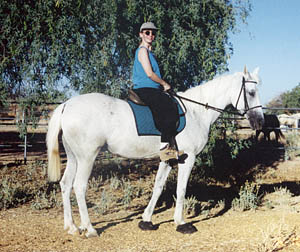
June 2001
Note in 2004: Inty sadly passed away in late 2004, at the age of 20. We are thankful for all the many important lessons that she taught us throughout the years, but most importantly, the lessons of the hoof. Because of her, all our future horses will live healthier, barefoot lives. She was our inspiration and will passage forever in our hearts. -- Yvonne & James
Note in September, 2009: This is a reprint, as published in a magazine in 2001. Please read this article as HISTORY, and as a WARNING, and understand that I do not agree with some of the "advice", which proved, inevitably, to be unsuccessful. I especially do not believe that any horse should live in pain, nor should it ever be forced to move while in pain, and I believe euthanasia can be an extremely kind option.
THE MORAL of this STORY: Save your horses NOW, while their hooves have not yet foundered, while they are still healthy. Prevention is everything. A healthy hoof is the ultimate prevention against hoof disease.
©2009 by The Horse's Hoof. All rights reserved. No part of these publications may be reproduced by any means whatsoever without the written permission of the publisher and/or authors. The information contained within these articles is intended for educational purposes only, and not for diagnosing or medicinally prescribing in any way. Readers are cautioned to seek expert advice from a qualified health professional before pursuing any form of treatment on their animals. Opinions expressed herein are those of the authors and do not necessarily reflect those of the publisher.
The Horse's Hoof Website
Home - About Us -
Articles - Barefoot Performance - Barefoot
Stories - Hoof Gallery
- Natural
Horse Care - EPSM
- Events - Trimmers
- Experts - Friends
- Classified - Resources
- News - Links
- Strasser
Hoofcare Links
To go shopping or subscribe to our magazine, please click here: The
Horse's Hoof Store
If you don't see a column to the left: To view the frames version of this site, please click here: TheHorsesHoof.com
The Horse's Hoof is a division of:
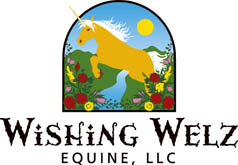
The Horse's Hoof
P.O. Box 1969
Queen Creek, AZ 85142
Phone (623) 935-1823
Message Phone: 1-623-935-1823
(Leave a message anytime.)
Email: editor @ TheHorsesHoof.com (delete spaces)